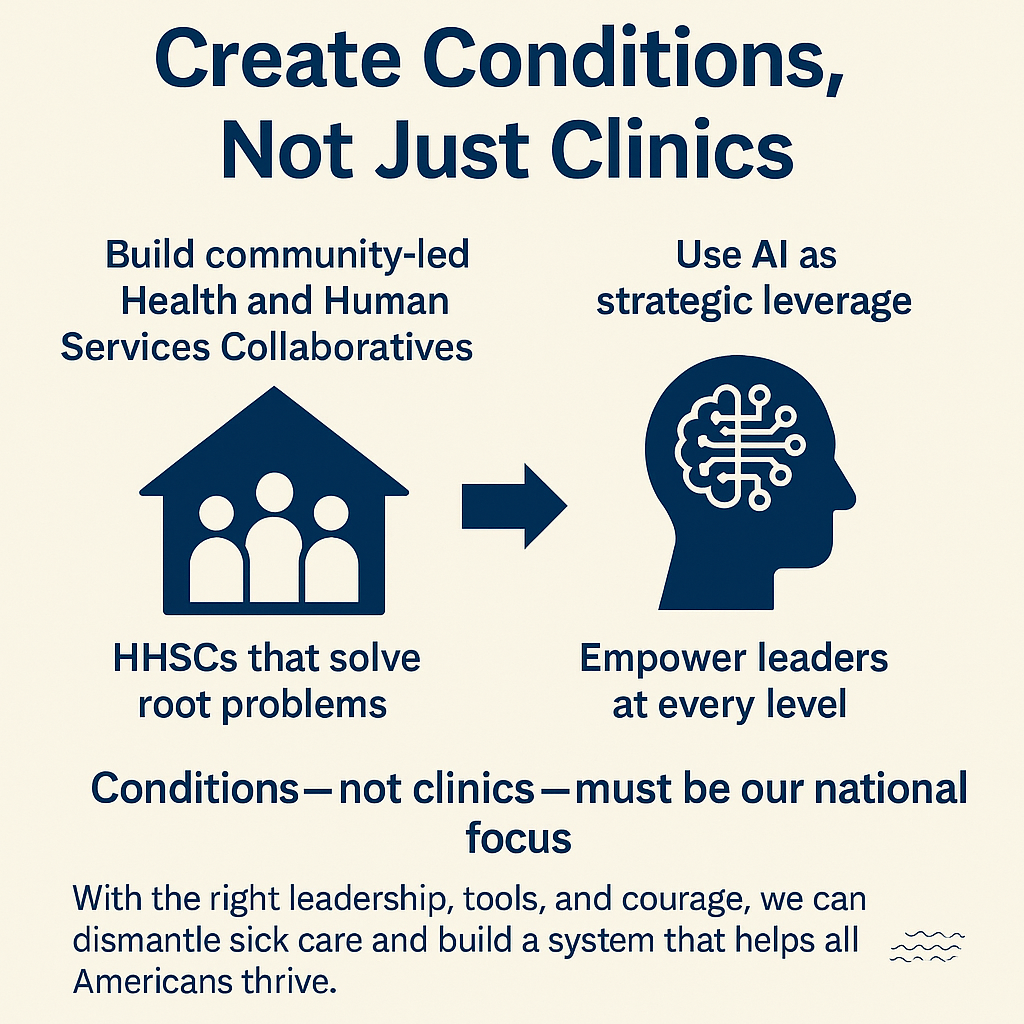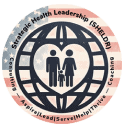Executive Summary: We cannot fix health by adding more clinics. Health starts with upstream action—addressing the structural and social drivers that create chronic illness and generational hardship. This article issues two calls to action: build community-led Health and Human Services Collaboratives (HHSCs) that solve root problems, and use AI as strategic leverage to empower leaders at every level. Conditions—not clinics—must be our national focus. With the right leadership, tools, and courage, we can dismantle sick care and build a system that helps all Americans thrive. This is part two of a two-part series. Part one made the case. Part two shows the way.
Table of Contents
Introduction: Create Conditions For Health, Not Just Clinics
We must stop treating Social Determinants of Health (SDOH) and Health-Related Social Needs (HRSN) as “add-ons” and start treating them as foundational infrastructure. SDOH are the upstream structures: income inequality, systemic racism, redlining, and environmental degradation. HRSNs are the immediate consequences: food insecurity, housing instability, and lack of transportation. Ignoring them is malpractice. Addressing them is the strategy: standard screening screen tools and address HRSN, sharing data across sectors, and reimbursement based on health, not production.

We do not need another white paper. We have had the blueprint for years. The Robert Wood Johnson Foundation (RWJF) laid it out clearly: build a Culture of Health rooted in shared values, cross-sector collaboration, and community engagement. Make health a daily priority—not just a clinical one. Align systems to make healthy choices easier, not harder. That is not theory—it is strategy. Start with the RWJF County-Level Health Rankings today!
The RIPPLE Foundation adds what RWJF started: Vital Conditions for Health and Wellbeing, as articulated by the RIPPLE Foundation. These are not buzzwords. They are structural prerequisites—humane housing, meaningful work, reliable transportation, lifelong learning, safe neighborhoods, and most importantly, belonging and civic muscle. These are the bedrock on which health, resilience, and economic mobility are built.
SHELDRs who understand these principles do not just improve access—they fix the foundation. They build Health and Human Services Collaboratives (HHSCs) and Integrated Accountable Community Health Systems (IACHS) to coordinate services, align funding, and hold everyone accountable for outcomes that matter. Without these conditions, health cannot take root.
Conditions create possibility. Integration makes it stick. To sustain genuine health, we need coordinated systems, not disjointed services that pretend to play team ball.
Integration, Collaboration, and Coordination
We must move beyond siloes of care and build Integrated Accountable Community Health Systems (IACHS). CMS has already launched components of this initiative with its Accountable Community Health Model, including screening for HRSNs, referral, connecting people to local services, community navigation services, and tracking impact to reduce healthcare utilization. IACHS takes it further: shared governance, unified data, joint budgeting, community engagement, and metrics that matter—such as quality of life, not just hospital readmissions.
Moreover, we cannot ignore the scale. Change happens at the individual, team, organizational, community, and system levels. These are not silos—they are levers. A policy shift at the system level changes budgets at the organizational level. That budget changes staffing at the team level. That team changes a life at the individual level. Then, the data is fed back into the system. This is systems thinking—not bureaucracy, but intentional interdependence.
To make it work, we need two calls to action (CTAs): community-level health and human services collaboratives (HHSC), championed by city, county, or regional leadership and stakeholders, and healthcare’s Black Swan: Artificial Intelligence (AI).
We know what is broken. We know what works. Now it is time to act—starting at the community level, where real coordination happens or does not.
CTA #1: Building Systems That Prevent, Not Patch
HHSCs are the glue and eye of the storm–conveners. A well-managed collaborative mobilizes teams of community leaders for action through planning, partnerships, and strategy execution. When local hospitals, schools, nonprofits, housing authorities, police, libraries, and employers coordinate—not compete—they can build something sustainable. However, they need aspirations, lateral leadership, and strength of will, not just hierarchy and fancy brochures. They need shared dashboards, pooled funding, and joint accountability.
SHELDRs apply coopetition (learn to compete, cooperate, and coordinate together) and lateral leadership skills to build multi-sector coalitions (e.g., hospitals, schools, social services) that align goals, share data, and coordinate care. Leadership is distributed—no command hierarchy. Coalition leaders employ open governance models, enabling schools, public health departments, health systems, and social service providers to take equal responsibility for community health.
However, even the best-run collaboratives cannot keep up without the right tools. That is where AI steps in—not as a savior, but as strategic support.
CTA #2: Technology That Works for People
Technology can help—but only if used strategically. Artificial intelligence (AI), the Black Swan of Healthcare, cannot save a broken philosophy and system. However, it can begin with a national plan, such as the Department of Health and Human Services’ Strategic Plan for the Use of Artificial Intelligence in Health, Human Services, and Public Health, followed by guidance acceleration to address the wicked and chronic conditions that are stifling the US health system. AI can predict chronic condition flare-ups, automate case management, flag unaddressed risks, and personalized care. It can scan zip code-level data for disparities and suggest evidence-based policy changes. It can help us act before disaster strikes and optimize resource allocation, budgets, and supply chains.
AI, as a SHELDR’s assistant, can also free up the very people who can drive this transformation. Junior supervisors can use it to track team burnout and draft documentation. Mid-career managers can model workflow changes and staffing plans. Senior executives can simulate five-year health impact projections. Systems leaders can use AI to unify insights from hundreds of programs into a shared strategy. AI is not magic—but it is leverage.
Actions You Can Take Today
The public is ready. The professionals are exhausted. The budget exists. The models are proven. The only thing missing is the courage to lead upstream.
SHELDRs do not wait for permission. They act. They build. They expose waste, challenge norms, and rewire systems to serve people, not processes. They embrace AI not only for the organization but also for themselves. If you are reading this, you are likely one of them—or you could be. If you are a local leader, convene an HHS collaborative and begin using ChatGPT. If you are a policymaker, fund IACHS pilots, tie payments to SDOH metrics, and get smarter on AI governance. If you are a health executioner, deploy AI to reduce burnout and improve care coordination.
Now is the time to stop patching the sick care machine. The wicked and chronic problems are not surmountable. It takes aspiration, strength of will, and embracing AI. Tear it down. Build a health system, not a sick care system. Forge a nation that does not just survive—but thrives.
This is your call. Will you lead, or will you wait for someone else to fix it?
Lean more at the SHELDR website: https://sheldr.com/
Let’s start the conversation!
To move from bold ideas to real action, leaders must ask the right questions—out loud, in the room, with their people. These questions are designed to kickstart two urgent conversations: how to build a functioning Health and Human Services Collaborative (HHSC) and how to use AI to support your team.
Questions to Launch a Community-Level HHSC
- What is stopping us from coordinating across schools, clinics, housing, and public health right now—and who must be at the table to fix that? (Targets fragmentation, siloed care, and community-level leadership alignment.)
- How can we design a shared dashboard, data-sharing protocol, or accountability structure that helps us track community-level health improvements, not just clinical visits? (Pushes toward shared metrics and open governance for HHSCs.)
- Which “vital conditions” for health and wellbeing—housing, transportation, civic belonging—are weakest in our community, and what would it take to fix them together?
- (Aligns HHSC efforts with RIPPLE’s measurable social drivers of health.)
- What would it look like to practice “coopetition” across our agencies—learning to compete, cooperate, and coordinate simultaneously to serve the public better? (Encourages lateral leadership and shared ambition beyond silos.)
Questions to Engage Staff on AI Benefits
- What is one task that wastes your time every week that AI could automate or streamline without reducing the quality of care or oversight? (Opens practical conversation on AI as personal assistant and burnout reducer.)
- How might we use AI tools to help track burnout, stress, or inefficiencies in our workflows—before they become problems? (Links AI to staff wellbeing and proactive team management.)
- Could AI help us improve our coordination across referrals, follow-ups, and community services—and what would it take to get started? (Targets use of AI to solve fragmentation and handoff failures.)
- What do you need to feel confident using AI in your daily work—training, policies, tools, or trust? (Addresses fear, skill gaps, and ownership of AI integration at all levels.)
20 Wicked and Chronic Problems in the U.S. Healthcare System
- High Healthcare Costs and Affordability: The U.S. faces persistently high healthcare expenditures, straining families and employers. Medical prices and insurance premiums have outpaced wage growth for years, leaving about half of U.S. adults struggling to afford care and one in four delaying or skipping needed treatment due to cost. These rising costs burden patients with medical debt, making health outcomes increasingly tied to one’s financial means.
- Gaps in Insurance Coverage: Despite gains from the Affordable Care Act, millions remain uninsured or underinsured. In 2022, the insured rate peaked at 92.3%, but the expiration of pandemic policies means 8–24 million people are expected to lose Medicaid coverage. Non-expansion of Medicaid in 10 states leaves an estimated 3.5 million low-income adults without coverage. Lapses in coverage lead to untreated conditions and preventable hospitalizations, highlighting the ongoing challenge of achieving universal coverage.
- Health Disparities and Equity Issues: Systemic inequities continue to drive worse outcomes in marginalized communities. For example, minority and low-income populations experienced higher COVID-19 mortality and have disproportionate rates of chronic diseases and maternal deaths. Structural factors, such as a lack of nutritious food, safe housing, and transportation, contribute to these disparities (healthcarecouncil.com). Closing these gaps remains a “wicked problem,” requiring multi-sector solutions to address social determinants of health.
- Chronic Disease Epidemic: The U.S. carries a massive burden of chronic illnesses such as heart disease, diabetes, and obesity. Fully 6 in 10 U.S. adults live with at least one chronic disease, and 4 in 10 have multiple conditions. These diseases account for approximately $4 trillion in annual healthcare spending. Managing and preventing chronic conditions is an enduring challenge, as lifestyle risk factors (poor diet, inactivity, tobacco) remain prevalent.
- Aging Population Pressures: The demographic wave of aging baby boomers is driving an increase in demand for healthcare and long-term care. More Americans are living into their 80s and 90s with multiple comorbidities, straining Medicare and the caregiver workforce. The “Silver Tsunami” of seniors will necessitate a shift in the system’s focus to geriatric care, chronic disease management, and end-of-life services on an unprecedented scale.
- Mental Health and Substance Use Crises: There is a growing mental health crisis and ongoing opioid epidemic in the U.S. Rates of depression and anxiety have climbed (especially among youth), yet access to therapy and psychiatric care remains limited. At the same time, drug overdose deaths have exceeded 100,000 annually for three years in a row. Hospitals and communities face rising needs for behavioral health and addiction treatment services, making mental health a top concern for healthcare CEOsache.org.
- Healthcare Workforce Shortages and Burnout: Hospitals and clinics are struggling with shortages of critical staff – from primary care doctors and psychiatrists to nurses and technicians. Projections show that the U.S. could face a shortage of up to 124,000 physicians by 2034. Likewise, nearly one-third of nurses (over 600,000) report plans to leave their jobs within 5 years, mainly due to stress and burnoutnetsuite.com. Workforce challenges have been the top concern of hospital CEOs for three consecutive years. Burnout rates remain high, fueled by excessive workloads, administrative burdens, and trauma from the COVID-19 pandemic.
- Fragmented Care and Poor Coordination: The U.S. healthcare system is notoriously fragmented, with patients often seeing multiple providers who do not effectively communicate. This fragmentation leads to gaps in care, duplicative tests, and medical errors. Notably, about 80% of serious medical errors involve miscommunication during care transitions between providers. Siloed electronic health records and lack of interoperability exacerbate the problem. Improving care coordination and continuity – especially for patients with complex or chronic conditions – remains an unmet, “wicked” challenge.
- Administrative Burden and Inefficiency: A significant share of U.S. healthcare spending goes to administrative overhead rather than clinical care. Providers face cumbersome billing and insurance procedures – for example, revenue cycle inefficiencies lead to ~15% of hospital revenues going uncollected. Prior authorization and claims denials by insurers have surged (11% of all claims denied in 2022, up 10% from 2021). These bureaucratic hurdles consume clinicians’ time and contribute to burnout. Efforts such as billing simplification and automation are underway, but paperwork and red tape continue to be chronic problems.
- Patient Safety Concerns: Preventable medical errors and hospital-acquired infections continue to harm patients at unacceptable rates. While safety initiatives have made progress, issues like medication errors, surgical complications, and diagnostic mistakes persist. An estimated 7,000–9,000 Americans die from medication errors each year, and about 80% of serious errors involve communication failures, as noted above. Ensuring consistent patient safety and quality of care is an ongoing struggle complicated by system complexity and human factors.
- Suboptimal Patient Experience: Patients frequently report frustration with long wait times, rushed appointments, poor communication, and difficulty navigating the system. The average wait for a new patient appointment in many areas is 26 days. Even basic tasks, such as scheduling, obtaining test results, or getting prescription refills, can be cumbersome. Such issues erode patient satisfaction and trust. Healthcare organizations are increasingly focusing on patient experience as a key quality dimension, offering conveniences such as online scheduling, telehealth, and patient portals to enhance access and engagement.
- High Drug Prices: The U.S. struggles with some of the highest prescription drug costs in the world. Many patients cannot afford life-saving medications due to a lack of pricing controls. Skyrocketing costs of specialty drugs (e.g., biologics, cancer therapies) put treatments out of reach and drive-up insurance premiums. Although recent policies (like allowing Medicare drug price negotiation) aim to temper costs, price transparency and affordability of medications remain critical challenges. High drug prices contribute to medication non-adherence and financial toxicity for patients.
- Cybersecurity Threats: Healthcare has become a prime target for cyberattacks due to the sensitive personal health data and critical systems it involves. Hospitals and insurers suffered over 180 ransomware attacks in 2024, with an average ransom of nearly $900,000. About 80% of such attacks disrupt patient care – downtime of IT systems forces diversions and can delay urgent treatments, sometimes with deadly consequences. The cost of a healthcare data breach now averages $10 million. Strengthening cybersecurity defenses and data protection is an urgent, ongoing need as digital health expands.
- Telehealth Sustainability and Reach: Telehealth usage surged 78-fold at the start of COVID-19, but its future is uncertain. With the pandemic emergency over, regulatory flexibilities are expiring. Utilization has dropped and remains concentrated in behavioral health services. Unresolved questions about reimbursement, licensure across state lines, and prescribing controlled substances via telemedicine have created doubts about telehealth’s future. Additionally, many seniors and rural residents face barriers related to technology or broadband access. The challenge is making virtual care a durable component of healthcare delivery – reaching underserved populations without sacrificing quality or continuity of care.
- Rapid Regulatory Changes: The healthcare sector is heavily regulated, and the pace of change has accelerated. New rules on price transparency, information blocking, telehealth, value-based payments, and more require constant adaptation. Keeping up with evolving regulations strains the administrative capacity of providers. For instance, hospitals must comply with price transparency mandates (posting complex pricing data) and surprise billing protections but face difficulties and resource constraints in doing so. Regulatory compliance, while necessary for accountability and patient rights, adds to the burden on health organizations already stretched thin.
- Transition to Value-Based Care: Moving away from fee-for-service toward value-based payment models is a long-term goal aimed at improving quality and lowering costs. However, this shift has proven challenging. Providers juggle numerous value-based programs (ACOs, bundled payments, chronic care models, etc.), each with distinct metrics and documentation requirements. The administrative burden of reporting quality and outcomes is substantial, often diverting time away from patient care. While Medicare aims to have most beneficiaries in value-based arrangements by 2030, many hospitals and clinicians feel unprepared and worry about financial risk. The path to value-based care will require simplified models and better support for providers to succeed.
- Disruption from New Entrants: Traditional healthcare providers face growing competition from retail and technology giants entering the care delivery market. Companies like Amazon, CVS, Walgreens, and Walmart are rapidly expanding into primary care, clinics, and home health. Between 2014 and 2023, the number of urgent care clinics doubled to 14,000, generating $35 billion in revenue. These alternative care sites attract patients with convenience and lower costs. While competition can spur innovation, it also pressures hospitals – especially in less profitable services – and fragments the market where patients seek care. Incumbent health systems must adapt business models and consumer experience in response to this disruption.
- Public Health Infrastructure Gaps: The COVID-19 pandemic exposed underinvestment in public health capacity. Issues included inadequate disease surveillance systems, supply chain failures (e.g., PPE, testing), and workforce shortages in public health agencies. Even after the pandemic, funding for public health and preparedness remains inconsistent. Challenges like managing future pandemics, combating antimicrobial resistance, and responding to climate-related health threats will test a public health system that is still rebuilding. Ensuring a robust public health infrastructure and emergency preparedness is a persistent challenge amid budget constraints and the boom-bust cycle of attention to public health.
- Healthcare Misinformation and Distrust: An “infodemic” of medical misinformation (especially online) has eroded public trust in health authorities. False claims about vaccines, treatments, and diseases spread rapidly on social media, contributing to vaccine hesitancy and resistance to public health measures. This fuels worse health outcomes – for instance, misinformation led to lower COVID-19 vaccination in some communities and preventable deaths. Healthcare leaders now face the challenge of effectively countering misinformation and rebuilding trust. Distrust also stems from historical injustices and current inequities, requiring healthcare organizations to engage with communities transparently and respectfully to regain their confidence.
- Complexity of Healthcare Delivery: The USA healthcare system itself is a complex chronic problem. Patients navigate a complex landscape of payers, providers, and protocols. Providers must navigate time consuming reimbursement rules and quality program rules. Multi-payer structure creates high administrative costs and fragmentation. Efforts to simplify – whether through unified financing, interoperable records, or care integration – face political and logistical hurdles. This complexity renders the system less efficient and more prone to errors. Tackling it involves aligning incentives and policies to make healthcare more seamless for both patients and caregivers – truly a “wicked” multi-faceted challenge.
#MakeAmericaHealthyAgain
#StrategicHealthLeadership
#TearDownSickCare
#BuildHealthNotHospitals
#AIforHealthJustice




